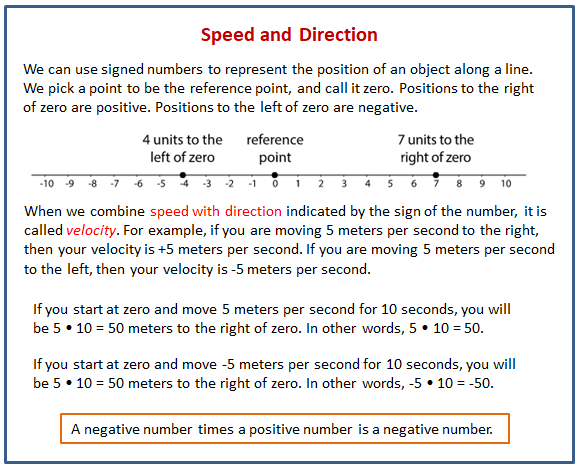Illustrative Mathematics Grade 7, Unit 5, Lesson 8: Position, Speed, and Direction
Learning Targets:
- I can multiply a positive number with a negative number.
- I can use rational numbers to represent speed and direction.
Related Pages
Illustrative Math
Grade 7
Lesson 8: Position, Speed, and Direction
Let’s use signed numbers to represent movement.
Illustrative Math Unit 7.5, Lesson 8 (printable worksheets)
Lesson 8 Summary
The following diagram shows how to use rational numbers to represent speed and direction.

Lesson 8.1 Distance, Rate, Time
- An airplane moves at a constant speed of 120 miles per hour for 3 hours. How far does it go?
- A train moves at constant speed and travels 6 miles in 4 minutes. What is its speed in miles per minute?
- A car moves at a constant speed of 50 miles per hour. How long does it take the car to go 200 miles?
Lesson 8.2 Going Left, Going Right
- After each move, record your location in the table. Then write an expression to represent the ending position that uses the starting position, the speed, and the time. The first row is done for you.
- How can you see the direction of movement in the expression?
- Using a starting position p, a speed s, and a time t, write two expressions for an ending position. One expression should show the result of moving right, and one expression should show the result of moving left.
Lesson 8.3 Velocity
A traffic safety engineer was studying travel patterns along a highway. She set up a camera and recorded the speed and direction of cars and trucks that passed by the camera. Positions to the east of the camera are positive, and to the west are negative.
Vehicles that are traveling towards the east have a positive velocity, and vehicles that are traveling towards the west have a negative velocity.
- Complete the table with the position of each vehicle if the vehicle is traveling at a constant speed for the indicated time period. Then write an equation.
- If a car is traveling east when it passes the camera, will its position be positive or negative 60 seconds after it passes the camera? If we multiply two positive numbers, is the result positive or negative?
- If a car is traveling west when it passes the camera, will its position be positive or negative 60 seconds after it passes the camera? If we multiply a positive and a negative number, is the result positive or negative?
Are you ready for more?
In many contexts we can interpret negative rates as “rates in the opposite direction.” For example, a car that is traveling -35 miles per hour is traveling in the opposite direction of a car that is traveling 40 miles per hour.
What could it mean if we say that water is flowing at a rate of -5 gallons per minute?
Make up another situation with a negative rate, and explain what it could mean.
-
Show Answer
It could mean that instead of the water flowing into a container, the water is flowing out of the container.
Lesson 8 Practice Problems
- A number line can represent positions that are north and south of a truck stop on a highway. Decide whether you want positive positions to be north or south of the truck stop. Then plot the following positions on a number line.
a. The truck stop
b. 5 miles north of the truck stop
c. 3.5 miles south of the truck stop - a. How could you distinguish between traveling west at 5 miles per hour and traveling east at 5 miles per hour without using the words “east” and “west”?
b. Four people are cycling. They each start at the same point. (0 represents their starting point.) Plot their finish points after five seconds of cycling on a number line
- Lin cycles at 5 meters per second
- Diego cycles at -4 meters per second
- Elena cycles at 3 meters per second
- Noah cycles at -6 meters per second
- Find the value of each expression.
- A shopper bought a watermelon, a pack of napkins, and some paper plates. In his state, there is no tax on food. The tax rate on non-food items is 5%. The total for the three items he bought was $8.25 before tax, and he paid $0.19 in tax. How much did the watermelon cost?
- For each equation, write two more equations using the same numbers that express the same relationship in a different way.
a. 3 + 2 = 5
b. 7.1 + 3.4 = 10.5
c. 15 - 8 = 7
d. 3/2 + 9/5 = 33/10 - Which graphs could not represent a proportional relationship? Explain how you decided.
The Open Up Resources math curriculum is free to download from the Open Up Resources website and is also available from Illustrative Mathematics.
Try out our new and fun Fraction Concoction Game.
Add and subtract fractions to make exciting fraction concoctions following a recipe. There are four levels of difficulty: Easy, medium, hard and insane. Practice the basics of fraction addition and subtraction or challenge yourself with the insane level.

We welcome your feedback, comments and questions about this site or page. Please submit your feedback or enquiries via our Feedback page.